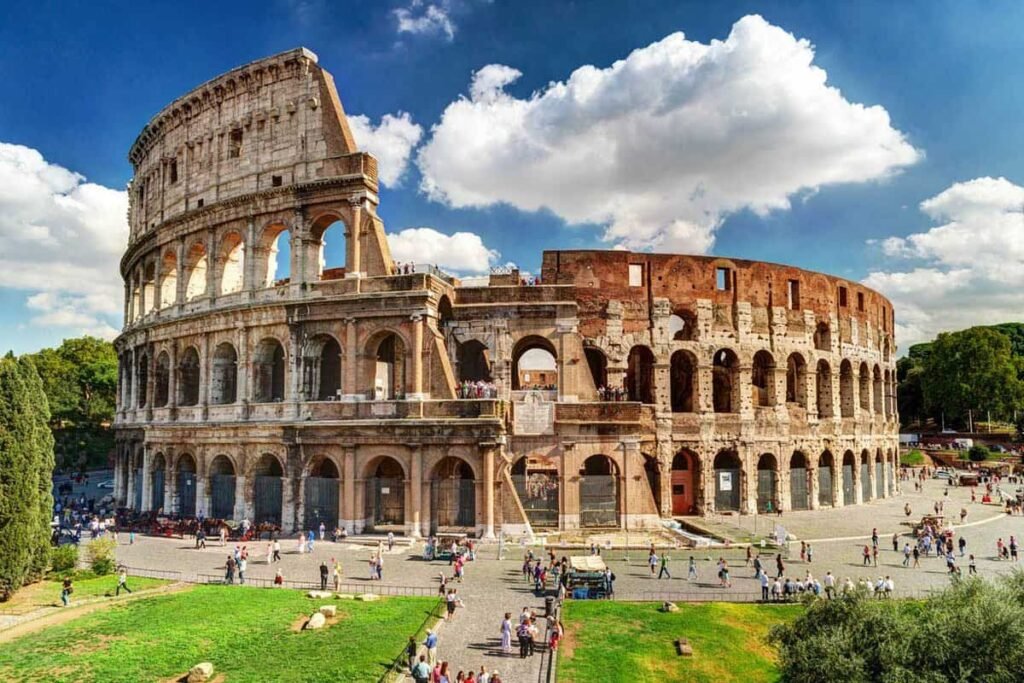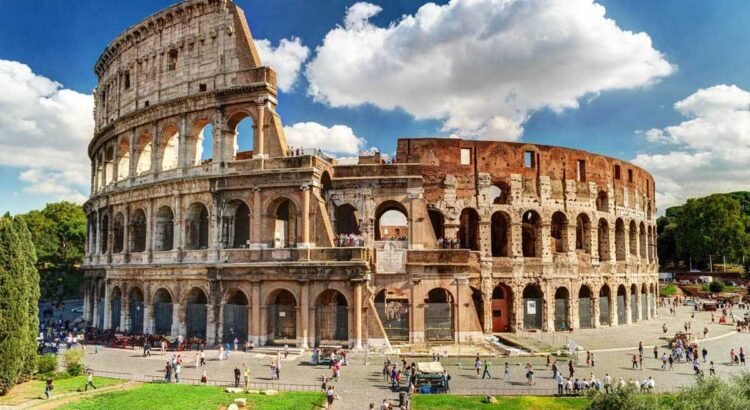
When you step into the Colosseum in Rome, you aren’t just entering a monument—you’re crossing a threshold into the mighty heart of the Roman Empire. Towering over the city for nearly two thousand years, the Colosseum is an awe-inspiring relic of ancient ingenuity, imperial ambition, and the dramatic spectacle of gladiator battles.
Its grand stone tiers, mighty arches, and weathered underground corridors still whisper stories of emperors, warriors, roaring crowds, and the dazzling machinery that once brought wild beasts, elaborate stagecraft, and heroism to life. Today, guided tours help transform these stones into vivid stories—allowing you to relive the triumphs, tragedies, and engineering marvels of one of the world’s greatest civilizations.
The Colosseum at First Glance: Majesty Etched in Stone
Approaching the Colosseum for the first time is nothing short of spellbinding. The massive elliptical amphitheater, built of travertine stone, rises from the ground like a fossilized crown, surrounded by modern Rome’s busy roads and bustling cafes. Despite centuries of erosion, earthquakes, and looting, its imposing outer walls still hint at the perfection and symmetry that once defined this engineering masterpiece.
The Colosseum stands approximately 50 meters (165 feet) tall, 189 meters (620 feet) long, and could hold between 50,000 and 80,000 spectators. With over 80 entrances and a complex seating arrangement based on social class, the amphitheater wasn’t just a stadium—it was a microcosm of Roman society.
A Gift to the People
Construction of the Colosseum began in 72 AD under Emperor Vespasian of the Flavian dynasty and was completed in 80 AD by his son Titus. Officially named the Flavian Amphitheater, the Colosseum was designed as a gift to the people of Rome—a gesture to win their loyalty and distract them from political unrest with “bread and circuses.”
This was more than just an arena. It was a showpiece of imperial power, meant to awe not just citizens, but foreign dignitaries and enemies alike. It demonstrated that Rome could tame nature, build eternally, and entertain its masses with unparalleled splendor.
Gladiators, Beasts, and Blood Sport
The Colosseum is best remembered for its gladiatorial combat—bloody, brutal, and mesmerizing.
Gladiators, often slaves or prisoners of war, trained for years in specialized schools. These men fought for survival and glory, sometimes gaining fame equivalent to modern athletes or celebrities. Some were volunteers, seeking wealth and prestige. Others were condemned criminals given one chance to earn their freedom.
The games were diverse. They included:
- Gladiator duels with swords, tridents, and nets.
- Beast hunts (venationes) where exotic animals—lions, elephants, bears, crocodiles—were released into the arena.
- Public executions, often dramatized as mythological stories.
- Naval battles (naumachiae): Although debated, some scholars suggest the arena was occasionally flooded to simulate sea battles.
These events were not random. They were carefully choreographed with music, narration, and theatrical spectacle. For the Roman people, it was a fusion of art, sport, myth, and politics.
Roman Engineering at Its Peak
Beyond the drama, the Colosseum represents one of the most sophisticated engineering feats of the ancient world.
- Velarium: A retractable awning system that shaded spectators using a complex rigging of ropes, pulleys, and sails operated by sailors from the Roman navy.
- Elevators and trapdoors: Ingenious lifts allowed animals and scenery to emerge dramatically from underground chambers.
- Drainage and flooding systems: The arena was equipped with elaborate water channels that enabled it to be cleaned—or perhaps even flooded—quickly.
The structure used concrete, travertine limestone, and tuff, materials chosen for strength and flexibility. Its tiered seating design allowed for rapid entry and exit (something modern stadiums still imitate), while the radial corridors and staircases ensured efficient crowd control.
Exploring the Arena Floor
Thanks to restoration efforts and modern tourism, visitors today can walk the reconstructed arena floor—once the central stage of the Roman world. Standing here, surrounded by stone bleachers and open sky, you can imagine the roar of 50,000 spectators, the clang of metal, the trumpets blaring, and the tension thick in the air as gladiators faced their fates.
The arena gives you a visceral sense of what it meant to fight for honor, to watch for spectacle, and to be caught in the fever of the crowd.
Beneath the Arena: The Hypogeum
Beneath the Colosseum lies the hypogeum, a vast labyrinth of underground tunnels, animal cages, waiting rooms, and elevators. This was the hidden engine room of the spectacle.
Here, animals were kept in darkness for days before being hoisted into the arena for dramatic “surprise” attacks. Gladiators and performers waited here for their cues, breathing the damp air, listening to the chaos above.
Thanks to guided tours, visitors can now access parts of the hypogeum. With every step, you uncover layers of Roman logistics, artistry, and power. Seeing the trapdoors and ancient pulley systems firsthand gives you immense appreciation for the sophistication of ancient stagecraft.
The View from the Top
Climbing to the upper levels of the Colosseum provides breathtaking views—not just of the structure itself, but of Rome’s historic skyline. You’ll see the Roman Forum, Palatine Hill, and the Arch of Constantine, revealing how interconnected these spaces were in ancient times.
From above, the elliptical shape of the arena becomes clear. You’ll also notice the stratification of seating—wealthy nobles close to the floor, commoners higher up, women and slaves furthest away. It’s a reminder that even in entertainment, status was strictly maintained.
The Arch of Constantine: Triumph and Transition
Adjacent to the Colosseum is the Arch of Constantine, a triumphal arch built in 315 AD to commemorate Constantine’s victory at the Battle of Milvian Bridge. It marks a turning point—the rise of Christianity and the eventual decline of public gladiatorial games.
The proximity of the arch to the Colosseum invites reflection: from pagan rituals to imperial conquest to spiritual transformation, Rome has always evolved—and its landmarks tell that story.
Guided Tours: Bringing History to Life
To truly appreciate the Colosseum, a guided tour is highly recommended. Guides—often historians or archaeologists—bring passion, precision, and storytelling flair that elevate your experience. Through them, you’ll hear little-known anecdotes, explore restricted areas, and understand the layers of culture, politics, and technology behind every stone.
Some tours even include virtual reality components, allowing you to see reconstructions of the Colosseum in its full glory—complete with cheering crowds, emperor’s box, and colorful frescoes.
Best Times to Visit
- Early morning: Fewer crowds, softer lighting, and cooler weather make for a more contemplative visit.
- Late afternoon: The golden hour casts a warm glow over the ruins, ideal for photography.
- Off-season (November to March): Cooler temperatures and fewer tourists offer a quieter, more intimate experience.
Advance booking is essential, especially for special access tours. Some combined tickets also include the Roman Forum and Palatine Hill—making it easy to extend your journey through ancient Rome.
Tips for Visitors
- Wear comfortable shoes: The Colosseum’s stone surfaces can be uneven.
- Bring water and sun protection: Especially in summer.
- Respect the site: It’s not just a tourist attraction—it’s a sacred historical monument.
The Colosseum Today: A Symbol of Endurance
Though no longer echoing with gladiatorial combat, the Colosseum has taken on new roles throughout the centuries. It was used as a fortress, a quarry, and even a Christian shrine. Today, it stands as a UNESCO World Heritage Site and one of the New Seven Wonders of the World.
Modern Rome embraces the Colosseum not just as a reminder of its imperial past, but as a symbol of cultural resilience, architectural brilliance, and the ongoing dialogue between antiquity and modernity.
Conclusion: A Timeless Encounter
To walk through the Colosseum is to trace the contours of human ambition—its triumphs, excesses, and eternal desire to create something lasting. Whether you’re marveling at the architecture, exploring its shadowy chambers, or imagining the thunderous applause of a Roman crowd, the Colosseum will captivate your imagination and stir your soul.
This is more than history. It’s a living encounter with the past—etched in stone, echoing with memory, and waiting for you to step inside.




